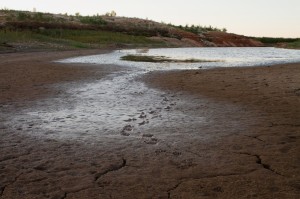A Brief History of the Texas Water Plan

REUTERS/Calle Richmond /LANDOV
E.V. Spence Reservoir in Robert Lee Texas is running dry. The latest iteration of the Texas Water Plan could help Texas' water supply, if it is funded.
During the worst of the Texas drought, in 2011, when temperatures soared, dessicated lake beds cracked open, rivers dried to a trickle and several towns nearly ran out of water, Texas Governor Rick Perry asked all Texans to pray for rain.
It was not a novel remedy to Texas’ recurring drought problem. Nearly 60 years earlier, in 1953, Governor Allen Shivers asked all of Texas’ ministers to pray for precipitation.
In addition to prayers, the drought of record — as the 1950s drought is known — also spurred Texas officials to write the first State Water Plan, forecasting Texas’ water needs in the coming decades. In November, Texans will decide whether to put $2 billion from the state’s rainy day fund to a contemporary version of that plan. So now may be a good time to look back the history of the water plan, its successes and failures, before making that choice.
Glancing back at those old water plans, one can see a document that shaped enduring features of the Texas landscape. But back when officials wrote the first plan, Texas was a different state, says Andy Sansom, Director of the Meadows Center for Water and the Environment at Texas State University.
“In the 1950s everybody lived in a small town,” Sansom told StateImpact Texas. “People lived on farms and ranches. Texas was a rural state. So, people understood what a drought meant because it affected their daily lives.”
Texas officials, with the pain of ’50s drought fresh in their minds, funded the first water plan in 1961 in a way that hasn’t been done since. One result was a dam building binge.
In ten years, the state built 2,700 dams to buttress the state’s water supply. Those dams account for about 40 percent of all the dams now in Texas. Notable lakes created during the period include Lakes Livingston, Toledo Bend and Sam Rayburn, three of Texas’ largest reservoirs.
But dams weren’t the only projects considered. A 1968 plan proposed channeling water from Louisiana. That “grandiose” plan seemed destined to fail, says Charles Porter, a Texas water historian and professor at St. Edwards University.
“How in the world do you run water from the Mississippi River, all the way across Texas?” Porter said in an interview with StateImpact Texas. “If we started that project today, I think maybe when my great grandchildren are alive they’ll have the right of way.”
There were also questions posed in the 1961 plan that have been repeated ever since.
“How much water does Texas have? That’s the most important question to figure out: where we are going to be. But it’s the hardest to determine,” Porter said.
One reason it’s difficult to tell how much freshwater there is in the state is Texas uses a huge amount of groundwater and it’s tough to tell how much water there is below the earth’s surface. Texas’ laws governing water ownership also complicate planning. The basis for water rights in Texas dates back to Spanish colonial times. Surface water (lakes and rivers) is public but groundwater is private.
To make matters worse, surface water and groundwater are essentially one and the same, say Sansom and Porter. Surface water can migrate underground then pop back out from a spring. There are several stretches of Central Texas’ Blanco River, for instance, that travel underground.
“It’s like a chameleon going through,” Porter said.
Another recurring question: how many people are going to need water in Texas? The early plans had some impressive demographic forecasting. The ’68 plan predicted Texas’ population in 2010 nearly dead-on at 25 million. But sound forecasting hasn’t pushed lawmakers toward fully funding the water plan for decades.
That’s what disaster is for.
“Water policy is driven by extremes, either extreme drought or extreme floods,” says Carolyn Brittin, Deputy Director of Water Planning with the Texas Water Development Board. “I think that it brings our attention to problems in the state. You know, we all have to have water to exist.”
Which brings us to today.
Over the past several years, the ongoing drought hasn’t tempered population growth in Texas. That means the state’s water supply is evaporating just as demand skyrockets. So, it may be no surprise that Texas is closer to funding the water plan in a way that hasn’t been done since the ’60s. But there’s a caveat, the 2012 water plan includes measures that ensure Texas saves more of the water it already has.
“There is money set aside that must be spent on conservation, and that’s a huge step forward,” says Sansom of the Meadows Institute.
This time around, for the first time in history, the citizens of Texas will have a direct say in the process. Come November, Texans will vote on whether to use $2 billion dollars from the state’s Rainy Day Fund, the state’s savings account, to fund projects in the latest water plan.
Voters will decide if the current drought calls for a historic solution.
David Barer is a freelance reporter with StateImpact Texas

